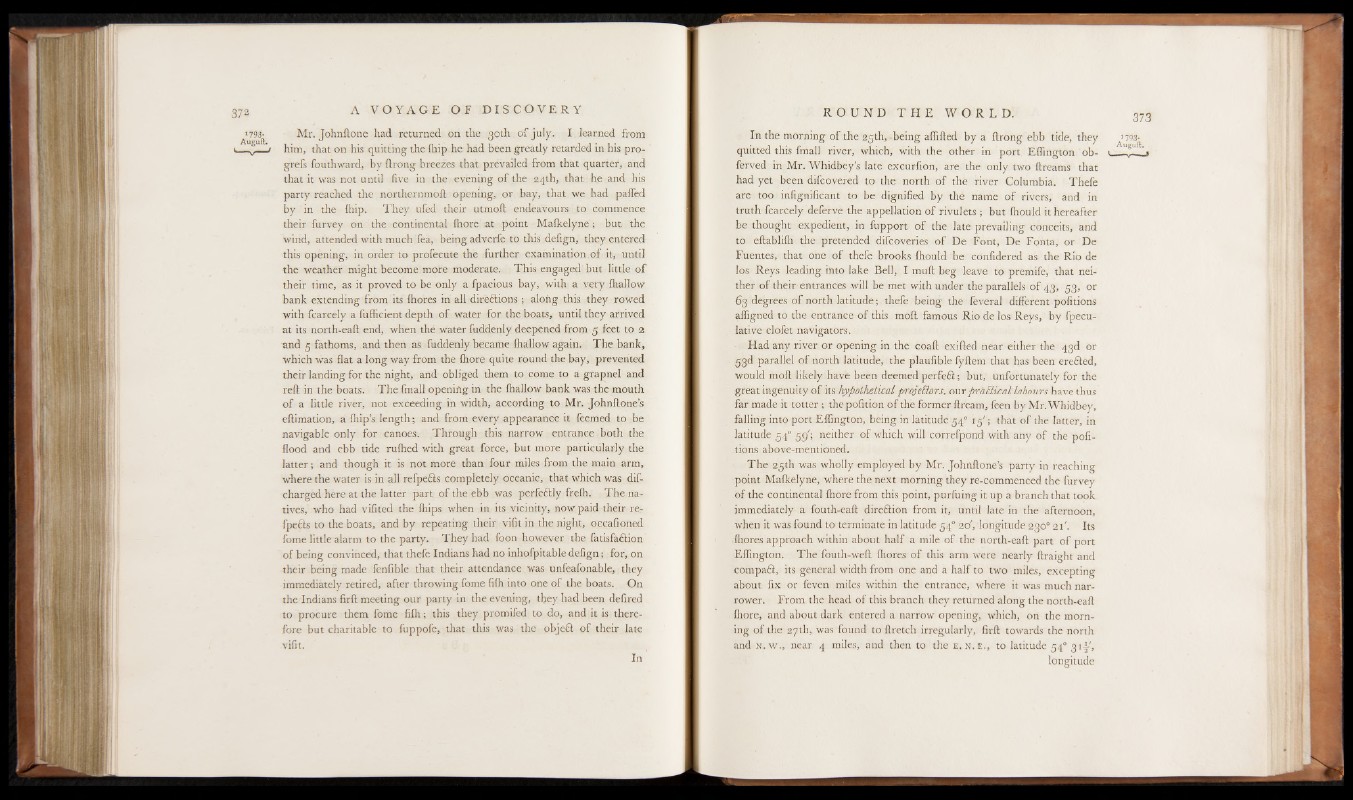
*793- Mr. Johnflone had returned on the 30th o f july. I . learned from
'• him, that on his quitting the Ihip he had been greatly retarded in his pro-
grefs fouthward, by ftrong breezes that prevailed from that quarter, and
that it was not until five in the evening of the 24th, that he and his
party reached the northernmoft opening, or bay, that we had pafled
by in the (hip. They ufed their utmoll endeavours to commence
their furvey on the continental fhore at point Mafkejyne; but the
wind, attended with much Tea, being adverfe to this defign, they entered
this opening, in order to profecute the further examination.of it, until
the weather might become more moderate. This engaged but little of
their time, as it proved to be only a fpacious bay, with a very fhallow
bank extending from its fhores in all direftions ; aloftg this they rowed
with fcarcely a fufficient depth of water for the boats, until they arrived
at its north-eaft end, when the water fuddenly deepened from 5 feet to 2
and 5 fathoms, and then as fuddenly became fhallow again. The bank,
which was flat a long way from the fhore quite round the bay, prevented
their landing for the night, and: obliged them to come to a grapnel and
reft in the boats. The fmall opening in the fhallow bank was the mouth
o f a little river, not exceeding in width, according to Mr. Johnftone’s
eftimation, a fhip’s length; and from every appearance it feemed to be
navigable only for canoes. .Through this narrow entrance both the
flood and ebb tide rufhed with great force, but more particularly the
latter; and though it is not more than four miles from the main arm,
where the water is in all refpefts completely oceanic, that which was dif-
charged here at the latter part of the ebb was perfeftly frefh. The natives,
who had vifited the fhips when in its vicinity, now paid their re-
fpefts to the boats, and by repeating their ■ vifit in the night, occafioned
fome little alarm to the party. They had foon-however the fatisfaftion
of being convinced, that thefe Indians had no inhofpitable defign; for, on
their being made fenfible that their attendance was unfeafonable, they
immediately retired, after throwingYome fifh into one of the boats. On
the Indians firft meeting our party in the evening, they had been defired
to procure them fome fifh; this they promifed to do, and it is therefore
but charitable to fuppofe, that this was the objeft o f their late
vifit.
In the morning o f the 25th, -being affifted by a ftrong ebb tide, they >793.
quitted this fmall river, which, with the other in port Eflington ob- ■
ferved in Mr. Whidbey’s late excurfion, are the only two ftreams that
had yet been difcovered to the north of the river Columbia. Thefe
are too infignificant to be dignified by the name o f rivers, and in
truth fcarcely deferve the appellation of rivulets ; but fhould it hereafter
be thought expedient, in fupport o f the late prevailing conceits, and
to eftablifh the pretended difcoveries of De Font, De Fonta, or De
Fuentes, that one of thefe brooks fhould be cönfidered as the Rio de
los Reys leading into lake Bell, I muft beg leave to premife, that neither
o f their entrances will be met with under the parallels o f 43, 53, or
63 degrees of north latitude; thefe being the feveral different pofitions
afligned to the entrance of this moft famous Rio de los Reys, by fpecu-
lative clofet navigators.
Had any river or opening in the coaft exifted near either the 43d or
53d parallel of north latitude, the plaufible fyftem that has been erefted,
would moft likely have been deemed perfeól; but, unfortunately for the
great ingenuity o f its hypothetical projectors, ourprhClical labours have thus
far made it totter ; thepofition of the former ftream, feen by Mr.Whidbey,
falling into port Eflington, being in latitude 54° 15'; that of the latter, in
latitude 540 59'; neither of which will correfpond with any o f the pofitions
above-mentioned.
The 25th was wholly employed by Mr. Johrtftone’s party in reaching
point Mafkelyne, where the next morning they re-commenced the furvey
of the continental fhore from this point, purfuing it up a branch that took
immediately a fouth-eaft direction from it, until late in the afternoon,
when it was found to terminate in latitude 54° 20', longitude 230° 21'. Its
fhores approach within about half a mile of the north-eaft part o f port
Eflington. The fouth-weft fhores of this arm were nearly ftraight and
compaft, its general width from one and a half to two miles, excepting
about fix or feven miles within the entrance, where it was much narrower.
From the head of this branch they returned along the north-eaft
fhore, and about dark entered a narrow opening, which, on the morning
of the 27th, was found to ftretch irregularly, firft towards the north
and n . w . , near 4 miles, and then to the e . n . e . , to latitude 540 31T',